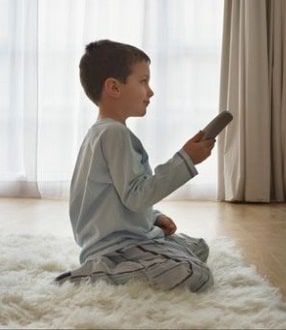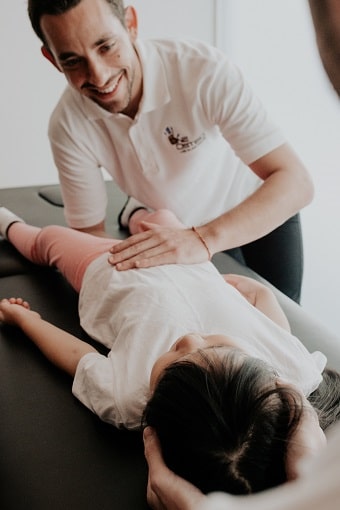Why is W-sitting position not recommended for your child?
“W sitting” is a common phrase for occupational, physical, and development therapists. There are a multitude of misconceptions regarding this particular sitting position to those not familiar with it. Let’s explore some of the reasons W-sitting is not recommended for children and when you should really worry.
What is W sitting position?
W sitting is a sitting position in which children sit with knees bent, feet tucked under, bottom resting on the floor between their legs, and legs out to either side. The child’s knees may be close to touching or may be splayed apart. Parents and therapists usually notice children W sitting between ages 3 to 6. Sometimes, you may also observe it with younger or older children.
When brought to the attention of parents, typical responses generally include “I’ve never noticed that before” or “I used to do that; it’s not a big deal.”
What’s wrong with W sitting position?
When your child sits in this way, their base of support is wider and their centre of gravity is lower. This position increases stability through their hips and trunk which makes it easier for them to play. Indeed, they don’t have to use their muscles to stay balanced.
3 common W sitting misconceptions debunked
Misconception #1: It doesn’t cause any long-term effects.
There is no excessive stress on a child’s joints, muscles or knees in the W position, because kids know how to avoid pain in their bodies.
The Truth: While your kid may find it more comfortable to sit in a W and will naturally avoid painful positions, W-sitting is usually a pattern that is used whenever the child is sitting on the floor. Over time, undeveloped bones and joints are affected by the routine stress on the hip and legs. Generally, we don’t worry about adjusting the W-sit pattern until about age 2 to 2.5. This is due to increased flexibility and malleability of bones and joints in infancy. Internal rotation (twisting inward) of the thighbone (which is called “femoral anteversion”) is fairly typical at a young age. It tends to decrease after age 8.
However, it is important to note that therapists see better results the earlier the problem is addressed. Age 8, or even 6 or 7, are considered advanced stages to discover issues with coordination and strength that could have been addressed or avoided altogether. Additionally, this pattern is also seen in kids who have other underlying issues, such as low tone, generalized muscle weakness, sensory concerns, and decreased fine and gross motor coordination.
Misconception #2: It’s more stable than other sitting positions.
 The Truth: W sitting can be a more stable sitting position for children. However, this is because in this W-sitting position, children do not have to work quite as hard to engage their core and hold their trunks upright. Instead, they spread their lower limbs to create a wider base of support, relying on their joint structures (and not their muscles) to hold them up. In this position, the muscles are not stabilizing the hip joints. This causes increased posterior pelvic tilt. The front of the pelvis rises and the back of the pelvis drops. That can result in poor sitting posture, decreased core activation, reduced trunk rotation, and delayed fine motor development.
The Truth: W sitting can be a more stable sitting position for children. However, this is because in this W-sitting position, children do not have to work quite as hard to engage their core and hold their trunks upright. Instead, they spread their lower limbs to create a wider base of support, relying on their joint structures (and not their muscles) to hold them up. In this position, the muscles are not stabilizing the hip joints. This causes increased posterior pelvic tilt. The front of the pelvis rises and the back of the pelvis drops. That can result in poor sitting posture, decreased core activation, reduced trunk rotation, and delayed fine motor development.
Due to the wide base of support utilized in the W-sitting position, less core muscle activation is required to stay upright. This wide base also limits a child’s need to weight shift on their bottom from side to side during play, resulting in decreased use of balance responses. This lack of activation causes a cycle of muscle weakness, resulting in difficulty integrating the left and right sides of the body, leading to decreased coordination. These impairments can lead to decreased play involving crossing over the body’s midline and poor progress with high-level fine motor tasks using two hands.
Misconception #3: “I sat like this all my life and I’ve never had any problems because of it.”
The Truth: According to Rebecca Cohen, DPT, PT, increasing the inward rotation of the hip while decreasing the outward range of motion can contribute to a pigeon-toed gait pattern. This walking pattern is correlated with excessive tripping, clumsiness, instability when walking and running, and decreased balance and body awareness.
Another joint abnormality that occurs is called tibial torsion, which is the outward rotation of the lower leg. While standing, this type of torsion causes the foot to turn outward and the knee to turn inward. This position can be painful. It also influences walking and running mechanics. With the foot facing outward, the last point of contact when walking becomes the outside ridge of the foot. This leads to abnormal gait mechanics. Walking can become tiring, slower, and painful. Children may also experience foot pain because of flattening arches. If untreated, adults can experience tight iliotibial (IT) bands, knee arthritis, and/or hip and back pain.
When Should You Worry About W Sitting position?
You might be wondering when should I worry. When is it really a problem? The truth is that W Sitting position by itself is not always a problem. In fact, when children use this position only rarely, it can often be no cause for alarm. However, there are cases when you should seek help from an osteopath.
If your child frequents the W Sitting pose and you notice any of the following in your child, an evaluation with an osteopath is advised:
If your child :
- develops a limp.
- has a a weakness in the lower extremities.
- uses a pigeon-toed gait.
- seems to have low muscle tone or weak core strength (as noted by slumping over in chair).
- is unable to sit alone in any position other than a “W”.
- seems clumsy or uncoordinated.
- has trouble with fine motor tasks (such as tying shoes, zippering his/her coat, opening containers, maintaining a hold on objects).
Then you should consider making an appointment with one of our osteopaths for an examination and assessment.
How can osteopathy help with w sitting position ?
 Most troubles are caused by mechanical disorders/ imbalances which will lead to a disruption of the movements. The Osteopath often finds a physical trauma to explain the appearance of mechanical imbalances.
Most troubles are caused by mechanical disorders/ imbalances which will lead to a disruption of the movements. The Osteopath often finds a physical trauma to explain the appearance of mechanical imbalances.
The psycho-motricity development is crucial since these steps, during the first year of life, will determine through movement, the abilities of the brain to develop and function. The absence of movement during one of these steps will affect how the brain has developed connections, so the inner and primary ability of an individual to find himself in space for an interact with others (sense of touch, etc).
The osteopath is perfectly skilled to diagnose any early imbalance that may disturb its future growth. The earlier you bring your baby, the easier your osteopath will be able to erase the print let by any trauma (birth, major falls, broken bones, etc…). Prevention is an essential aspect of osteopathy. We all need and deserve a fully functional and balanced body to live our lives.
About the author
Pierre Rubert is a senior osteopath at OneOsteo. He graduated from Atman Osteopathic College in 2010 after 5 years full-time studies. In 2009, he graduated from the Phenix Center and was certified in animal osteopathy to treat horses, cats, dogs.
Learn more about Pierre




